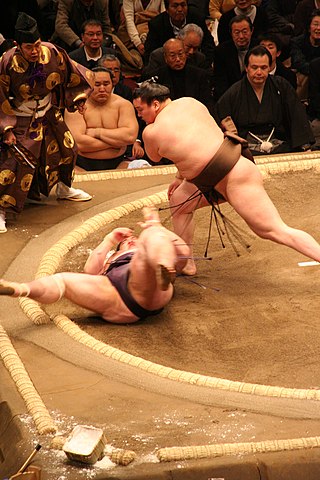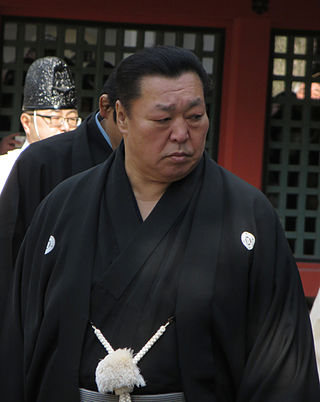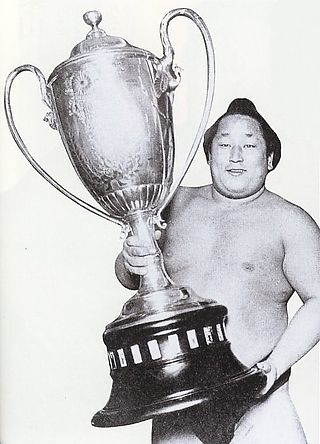Related Research Articles

Sumo is a form of competitive full-contact wrestling where a rikishi (wrestler) attempts to force his opponent out of a circular ring (dohyō) or into touching the ground with any body part other than the soles of his feet.

Makuuchi (幕内), or makunouchi (幕の内), is the top division of the six divisions of professional sumo. Its size is fixed at 42 wrestlers (rikishi), ordered into five ranks according to their ability as defined by their performance in previous tournaments.

Taihō Kōki was a Japanese professional sumo wrestler. He became the 48th yokozuna in 1961 at the age of 21, the youngest ever at the time.

Kitanoumi Toshimitsu, born Toshimitsu Obata, was a Japanese professional sumo wrestler. He was the dominant wrestler in the sport during the 1970s. Kitanoumi was promoted to yokozuna at the age of 21, becoming the youngest ever to achieve sumo's top rank. He won 24 tournament championships during his career and was one of a series of truly great yokozuna who came from Hokkaido, the largest and northernmost prefecture of Japan. At the time of his death he still held the records for most tournaments at yokozuna (63) and most bouts won as a yokozuna (670), but they have since been surpassed. Following his retirement in 1985 he established the Kitanoumi stable. He was chairman of the Japan Sumo Association from 2002 until 2008, and again from 2012 until his death.
Takamiyama Daigorō is an American-born Japanese former professional sumo wrestler. Wrestling for Takasago stable for twenty years from 1964 to 1984, his highest rank was sekiwake. Takamiyama set a number of longevity records in sumo, including most tournaments ranked in the top makuuchi division, and most consecutive top division appearances. In July 1972, he became the first foreign-born wrestler to win the top division championship. He is also the first foreign-born wrestler ever to take charge of a training stable, founding Azumazeki stable in 1986. His most successful wrestler was fellow Hawaiian Akebono who reached the sport's highest rank of yokozuna in 1993. Takamiyama retired as a coach in 2009.

Kyokutenhō Masaru in Nalaikh, Ulaanbaatar, Mongolian People’s Republic is a former professional sumo wrestler. He fought out of Ōshima stable, with the first group of Mongolians ever to join the sport in Japan.

Hiroshi Wajima was a Japanese professional sumo wrestler from Nanao, Ishikawa. He was the sport's 54th yokozuna and remains the only wrestler with a collegiate background to reach its highest rank. Entering professional sumo in 1970, he won a total of 14 tournament championships or yūshō during his career before retiring in March 1981. He was later head coach of Hanakago stable, but after several controversies, Wajima was forced to leave the sumo world and turned to professional wrestling.

Takanosato Toshihide, real name Toshihide Takaya, was a Japanese professional sumo wrestler from Namioka, Aomori. He was the sport's 59th yokozuna from 1983 to 1986 and won four top division tournament championships. After retirement he established Naruto stable which he ran from 1989 until his death.
Takatōriki Tadashige is a former sumo wrestler and professional wrestler from Kobe, Japan. He made his professional debut in 1983, reaching the top division in 1990. His highest rank was sekiwake. Known for his great fighting spirit, he won 14 tournament prizes, including a record ten Kantō-shō, and earned nine gold stars for defeating yokozuna ranked wrestlers. He wrestled for the highly successful Futagoyama stable. He was twice runner-up in top division tournaments and in March 2000, from the maegashira ranks, he unexpectedly won the yūshō or championship. He retired in 2002 and became the head coach of Ōtake stable, having married the daughter of the previous owner of the heya, the great yokozuna Taihō. However, he was dismissed from the Sumo Association in 2010 for his role in an illegal gambling scandal.

Kotomitsuki Keiji is a Japanese former professional sumo wrestler from Okazaki City. A former amateur champion, he turned professional in 1999. He reached the top makuuchi division in November 2000 and won one yūshō or tournament championship, in September 2001. He was a runner-up in eight other tournaments, and earned thirteen sanshō or special prizes. He is one of six wrestlers in the history of sumo to receive all three sanshō in the same tournament, accomplishing the feat in the November 2000 honbasho. After a record 22 tournaments at sekiwake, he achieved promotion to sumo's second highest rank of ōzeki in July 2007 upon winning 35 out of 45 bouts in three consecutive tournaments. This made him at 31 the oldest man to reach ōzeki in the modern era. He wrestled for Sadogatake stable. On July 4, 2010, he was expelled from professional sumo by the Japan Sumo Association for his involvement in an illegal gambling ring.

Tamanishiki San'emon was a Japanese professional sumo wrestler from Kōchi. He was the sport's 32nd yokozuna. He won a total of nine top division yūshō or tournament championships from 1929 to 1936, and was the dominant wrestler in sumo until the emergence of Futabayama. He died whilst still an active wrestler.

Akinoumi Setsuo, born Nagata Setsuo, was a Japanese professional sumo wrestler from Hiroshima. He was the sport's 37th yokozuna.
Wakanohana Kanji was a Japanese professional sumo wrestler from Ōwani, Aomori. He was the sport's 56th yokozuna. He was popular with sumo fans and was well-known for his rivalry with Kitanoumi. After retirement, he became the head coach of Magaki stable. Due to poor health, he left the Japan Sumo Association in December 2013. He died of lung cancer in July 2022 at the age of 69.

Terao Tsunefumi was a Japanese sumo wrestler. He was born in Tokyo, but brought up in Kajiki, Aira District, Kagoshima, Japan. He fought out of Izutsu stable. The highest rank he reached was sekiwake. Despite his relatively light weight he had an extremely long career, spanning 23 years from 1979 until 2002, and was known as the "iron man" of sumo. After retiring, he was the owner of the Shikoroyama stable until his death in 2023.

Tokitenkū Yoshiaki was a sumo wrestler.

Kasugaō Katsumasa is a former sumo wrestler from Incheon, South Korea. He was the first sumo wrestler to reach the top makuuchi division officially representing South Korea.. He joined sumo in 1998, making the top division for the first time in 2003. His highest rank was maegashira 3. In September 2009, he acquired Japanese citizenship. In April 2011 he was ordered to retire by the Japan Sumo Association after an investigation found him guilty of match-fixing.
Asashio Tarō IV was a Japanese sumo wrestler from Muroto, Kōchi, Japan. His highest rank was ōzeki. A former amateur champion, he turned professional in 1978. He won one top division tournament championship and was a runner-up on four other occasions. He won fourteen special prizes, including a record ten Outstanding Performance Awards, and five gold stars for defeating yokozuna. He retired in 1989 and became head coach of the Wakamatsu stable, which in 2002 merged with Takasago stable. As a coach, he raised yokozuna Asashōryū and ōzeki Asanoyama. He stood down as an elder in 2020.

Futatsuryū Jun'ichi was a sumo wrestler from Hokkaidō, Japan. After retirement he became the head coach of Tokitsukaze stable. Following his involvement in the hazing and death of trainee Takashi Saito, in October 2007 he became the first serving stablemaster to be dismissed by the Japan Sumo Association. In May 2009 he was sentenced to six years in prison. He died on August 12, 2014, of lung cancer.
Fujinokawa Takeo is a former sumo wrestler from Otofuke, Hokkaido, Japan. He made his professional debut in May 1961 and reached a highest rank of sekiwake in May 1967. He was a runner-up in two top division (makuuchi) tournaments, finishing three wins behind Tamanoshima in May 1968 and losing a playoff to ozeki Kiyokuni in July 1969. He earned four kinboshi for defeating yokozuna and won seven special prizes. After his retirement in 1972 at the age of 26 he became an elder of the Japan Sumo Association and took over as head coach of Isenoumi stable in 1982. He left the Sumo Association in 2011 upon reaching 65 years of age.
Higonoumi Naoya is a former sumo wrestler from Kumamoto, Japan. After his retirement he opened up Kise stable.
References
- ↑ "Hanahikari Setsuo Kabu History". Sumo Reference. Retrieved 13 September 2012.
- ↑ "Hanahikari Setsuo Rikishi Information". Sumo Reference. Retrieved 25 June 2020.